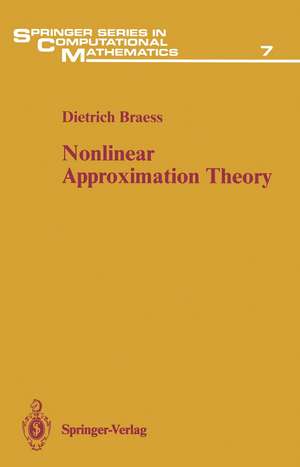Nonlinear Approximation Theory: Springer Series in Computational Mathematics, cartea 7
Autor Dietrich Braessen Limba Engleză Paperback – oct 2011
Din seria Springer Series in Computational Mathematics
- 24%
 Preț: 703.00 lei
Preț: 703.00 lei - 15%
 Preț: 497.64 lei
Preț: 497.64 lei - 18%
 Preț: 726.85 lei
Preț: 726.85 lei -
 Preț: 403.91 lei
Preț: 403.91 lei -
 Preț: 386.61 lei
Preț: 386.61 lei - 18%
 Preț: 1399.11 lei
Preț: 1399.11 lei -
 Preț: 394.51 lei
Preț: 394.51 lei - 18%
 Preț: 1395.94 lei
Preț: 1395.94 lei - 18%
 Preț: 784.48 lei
Preț: 784.48 lei - 20%
 Preț: 996.22 lei
Preț: 996.22 lei - 24%
 Preț: 635.73 lei
Preț: 635.73 lei - 15%
 Preț: 649.22 lei
Preț: 649.22 lei -
 Preț: 400.47 lei
Preț: 400.47 lei - 18%
 Preț: 740.44 lei
Preț: 740.44 lei - 15%
 Preț: 643.65 lei
Preț: 643.65 lei -
 Preț: 380.63 lei
Preț: 380.63 lei - 18%
 Preț: 904.74 lei
Preț: 904.74 lei - 18%
 Preț: 1014.28 lei
Preț: 1014.28 lei - 18%
 Preț: 1111.97 lei
Preț: 1111.97 lei -
 Preț: 393.90 lei
Preț: 393.90 lei - 18%
 Preț: 947.98 lei
Preț: 947.98 lei - 15%
 Preț: 650.04 lei
Preț: 650.04 lei - 15%
 Preț: 658.05 lei
Preț: 658.05 lei - 15%
 Preț: 521.60 lei
Preț: 521.60 lei - 15%
 Preț: 660.04 lei
Preț: 660.04 lei - 18%
 Preț: 1397.52 lei
Preț: 1397.52 lei - 18%
 Preț: 1126.35 lei
Preț: 1126.35 lei - 18%
 Preț: 1117.48 lei
Preț: 1117.48 lei - 18%
 Preț: 793.76 lei
Preț: 793.76 lei - 15%
 Preț: 710.23 lei
Preț: 710.23 lei
Preț: 727.31 lei
Preț vechi: 886.97 lei
-18% Nou
Puncte Express: 1091
Preț estimativ în valută:
139.17€ • 145.69$ • 115.15£
139.17€ • 145.69$ • 115.15£
Carte tipărită la comandă
Livrare economică 05-19 aprilie
Preluare comenzi: 021 569.72.76
Specificații
ISBN-13: 9783642648830
ISBN-10: 3642648835
Pagini: 308
Ilustrații: XIV, 290 p.
Dimensiuni: 155 x 235 x 16 mm
Greutate: 0.44 kg
Ediția:Softcover reprint of the original 1st ed. 1986
Editura: Springer Berlin, Heidelberg
Colecția Springer
Seria Springer Series in Computational Mathematics
Locul publicării:Berlin, Heidelberg, Germany
ISBN-10: 3642648835
Pagini: 308
Ilustrații: XIV, 290 p.
Dimensiuni: 155 x 235 x 16 mm
Greutate: 0.44 kg
Ediția:Softcover reprint of the original 1st ed. 1986
Editura: Springer Berlin, Heidelberg
Colecția Springer
Seria Springer Series in Computational Mathematics
Locul publicării:Berlin, Heidelberg, Germany
Public țintă
ResearchCuprins
I. Preliminaries.- § 1. Some Notation, Definitions and Basic Facts.- § 2. A Review of the Characterization of Nearest Points in Linear and Convex Sets.- § 3. Linear and Convex Chebyshev Approximation.- §4. L1-Approximation and Gaussian Quadrature Formulas.- II. Nonlinear Approximation: The Functional Analytic Approach.- §1. Approximative Properties of Arbitrary Sets.- §2. Solar Properties of Sets.- § 3. Properties of Chebyshev Sets.- III. Methods of Local Analysis.- §1. Critical Points.- §2. Nonlinear Approximation in Hilbert Spaces.- § 3. Varisolvency.- §4. Nonlinear Chebyshev Approximation: The Differentiable Case.- §5. The Gauss-Newton Method.- IV. Methods of Global Analysis.- §1. Preliminaries. Basic Ideas.- §2. The Uniqueness Theorem for Haar Manifolds.- §3. An Example with One Nonlinear Parameter.- V. Rational Approximation.- §1. Existence of Best Rational Approximations.- §2. Chebyshev Approximation by Rational Functions.- §3. Rational Interpolation.- §4. Padé Approximation andMoment Problems.- §5. The Degree of Rational Approximation.- §6. The Computation of Best Rational Approximations.- VI. Approximation by Exponential Sums.- §1. Basic Facts.- §2. Existence of Best Approximations.- §3. Some Facts on Interpolation and Approximation.- VII. Chebyshev Approximation by ?-Polynomials.- §1. Descartes Families.- §2. Approximation by Proper ?-Polynomials.- §3. Approximation by Extended ?-Polynomials: Elementary Theory.- §4. The Haar Manifold Gn\Gn?1.- §5. Local Best Approximations.- §6. Maximal Components.- §7. The Number of Local Best Approximations.- VIII. Approximation by Spline Functions with Free Nodes.- §1. Spline Functions with Fixed Nodes.- §2. Chebyshev Approximation by Spline Functions with Free Nodes.- §3. Monosplines of Least L?-Norm.- §4. Monosplines of Least L1-Norm.- §5. Monosplines of Least Lp-Norm.- Appendix. The Conjectures of Bernstein and Erdös.













